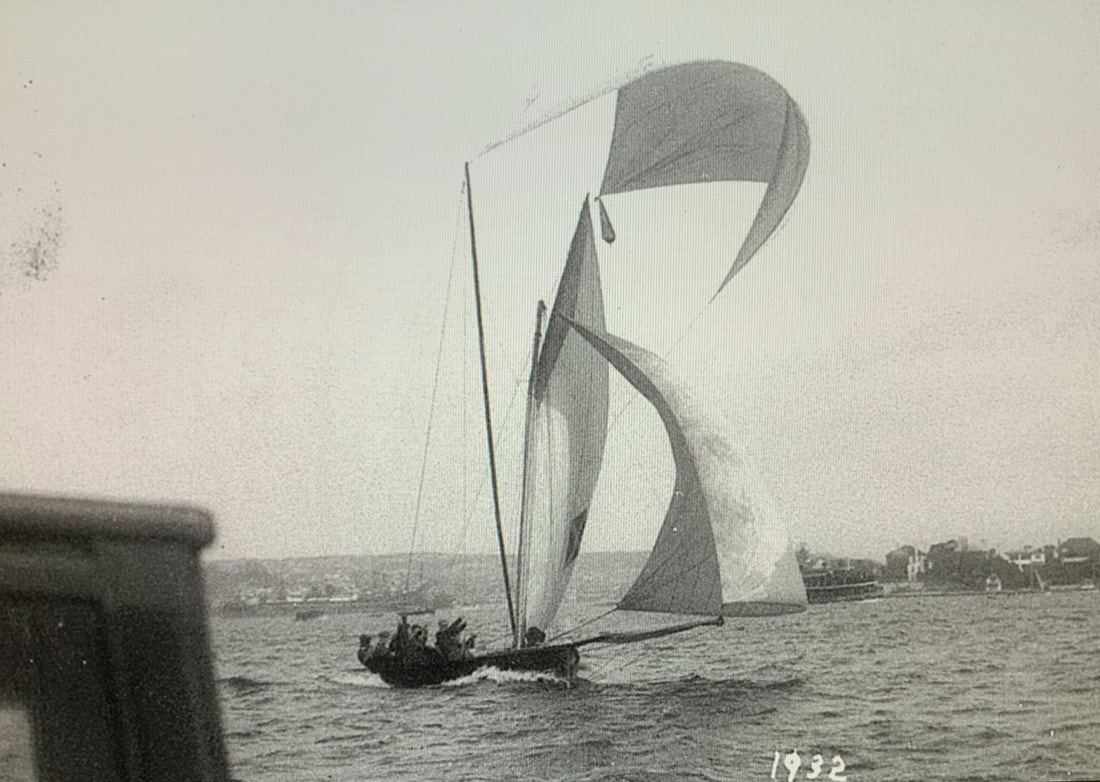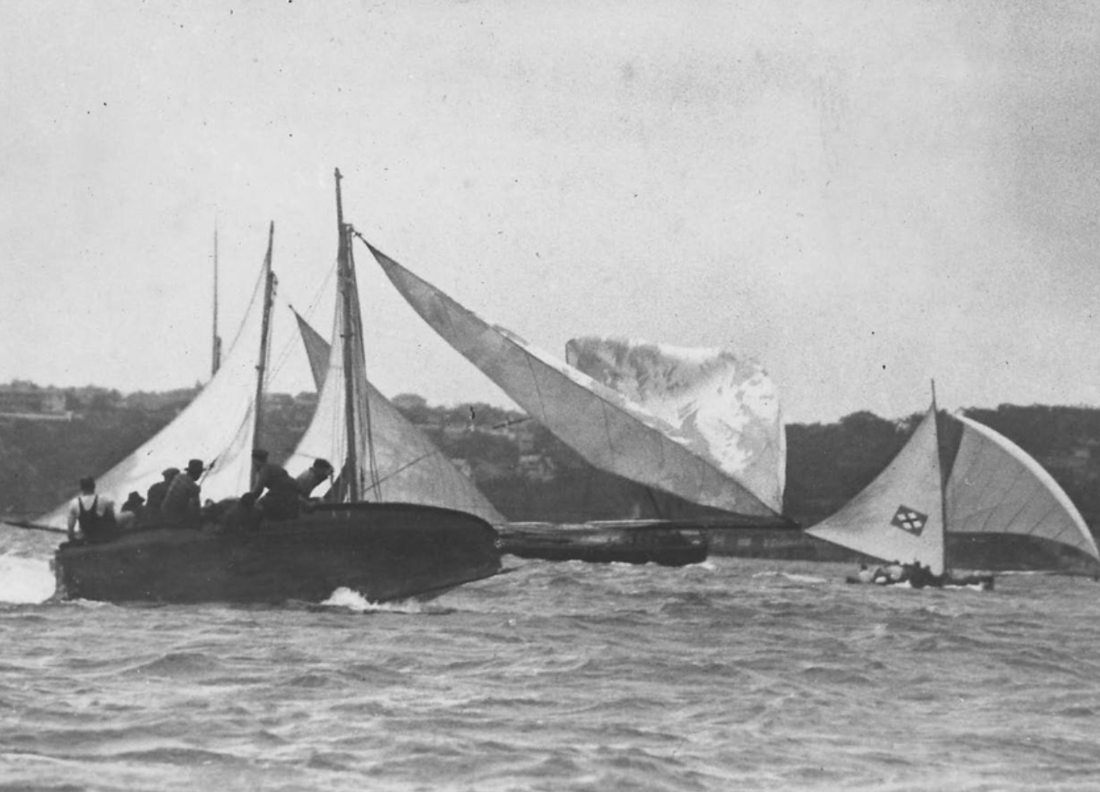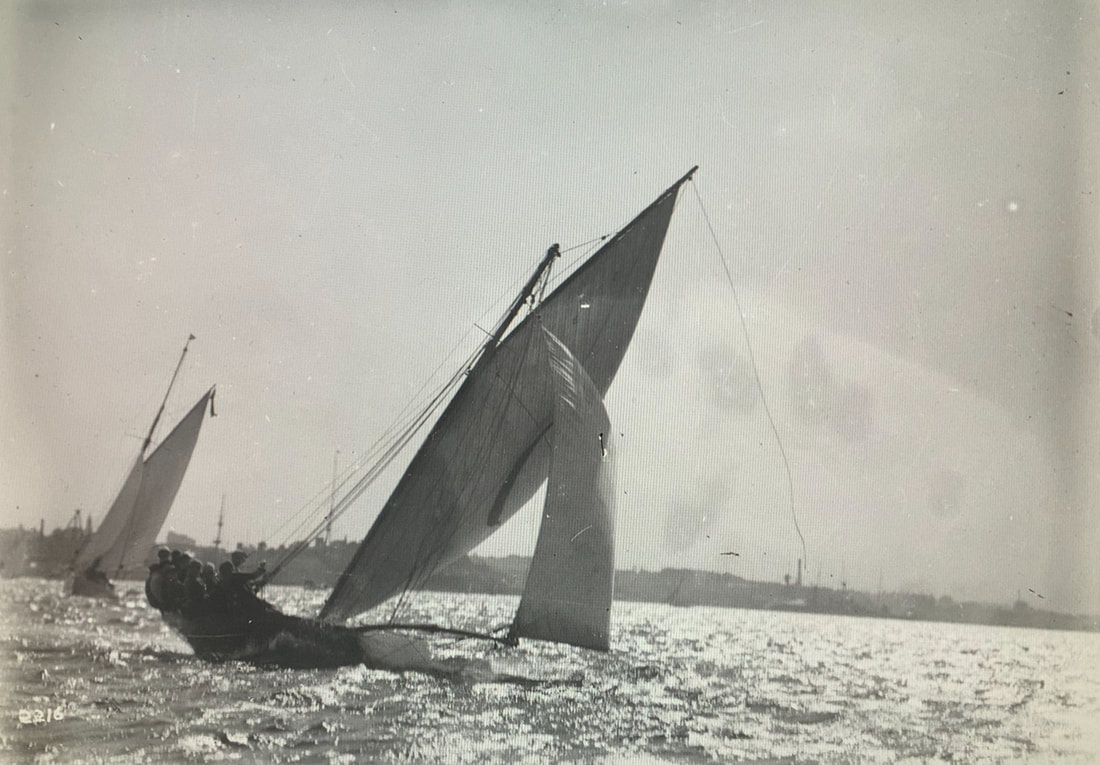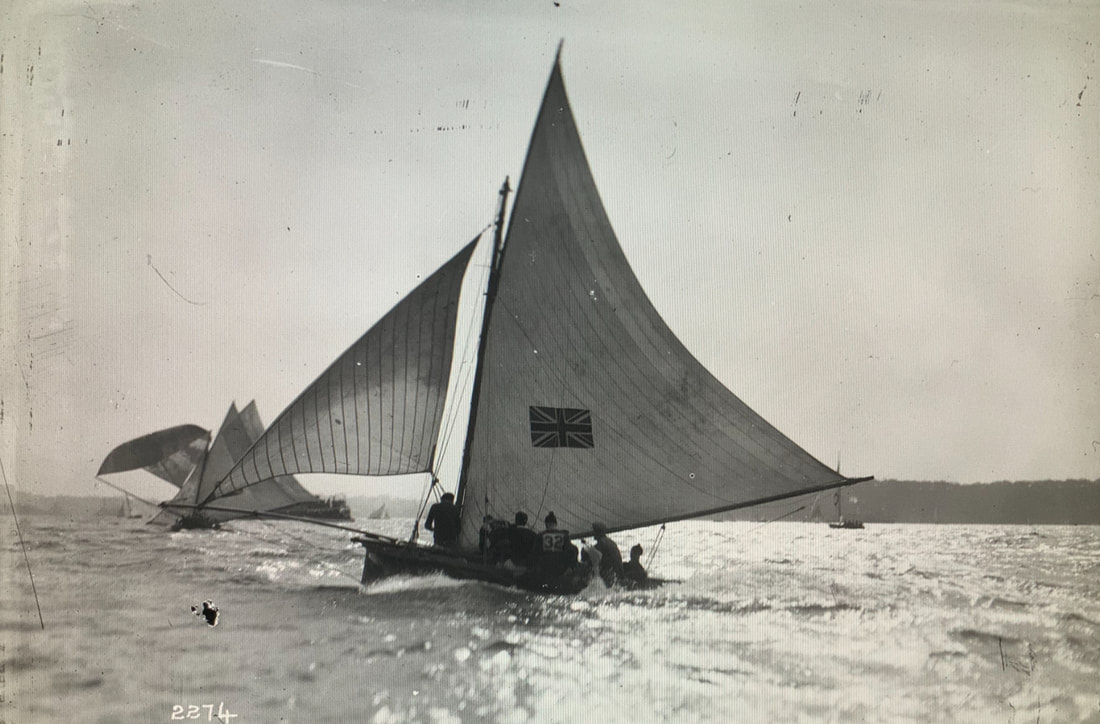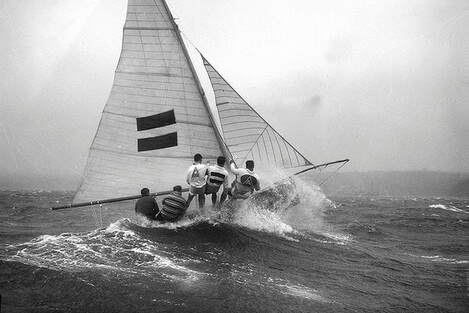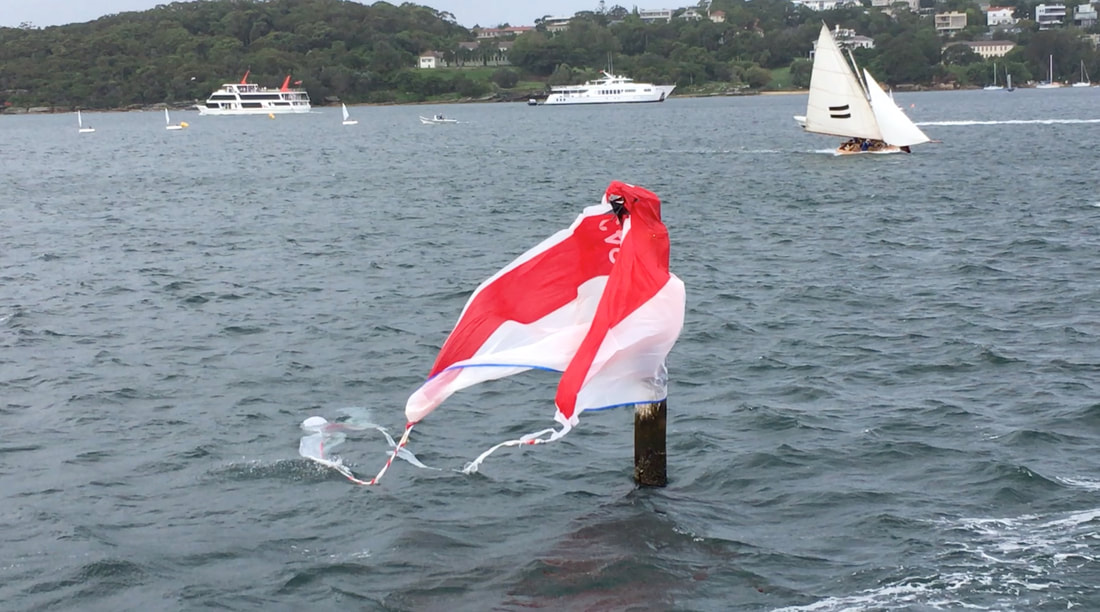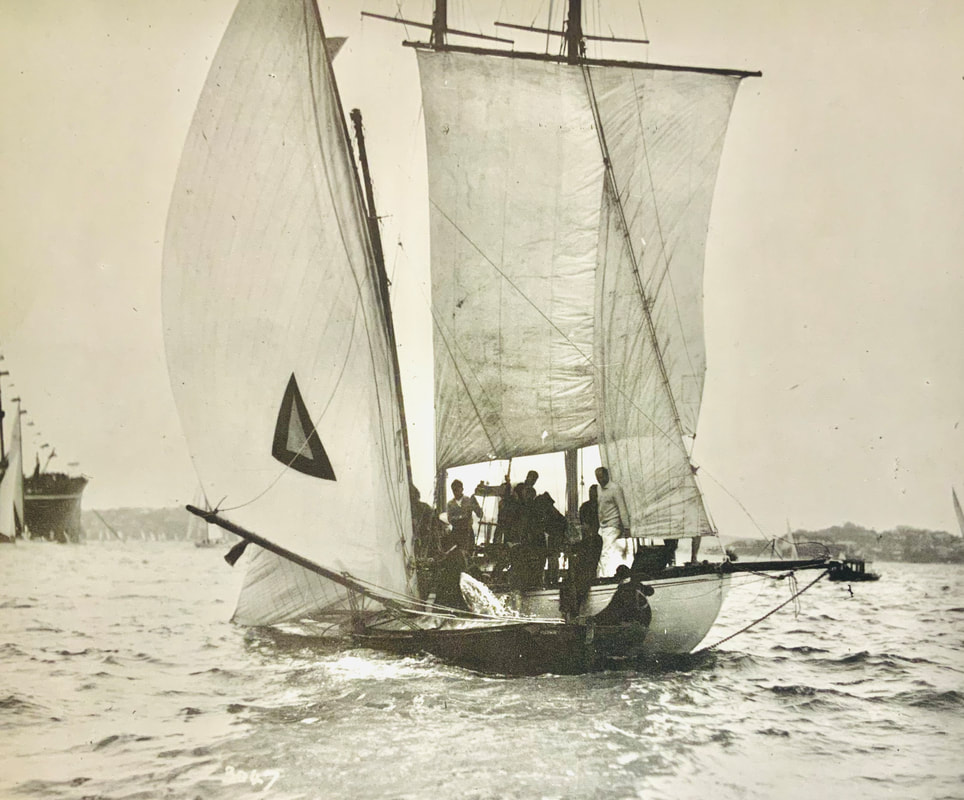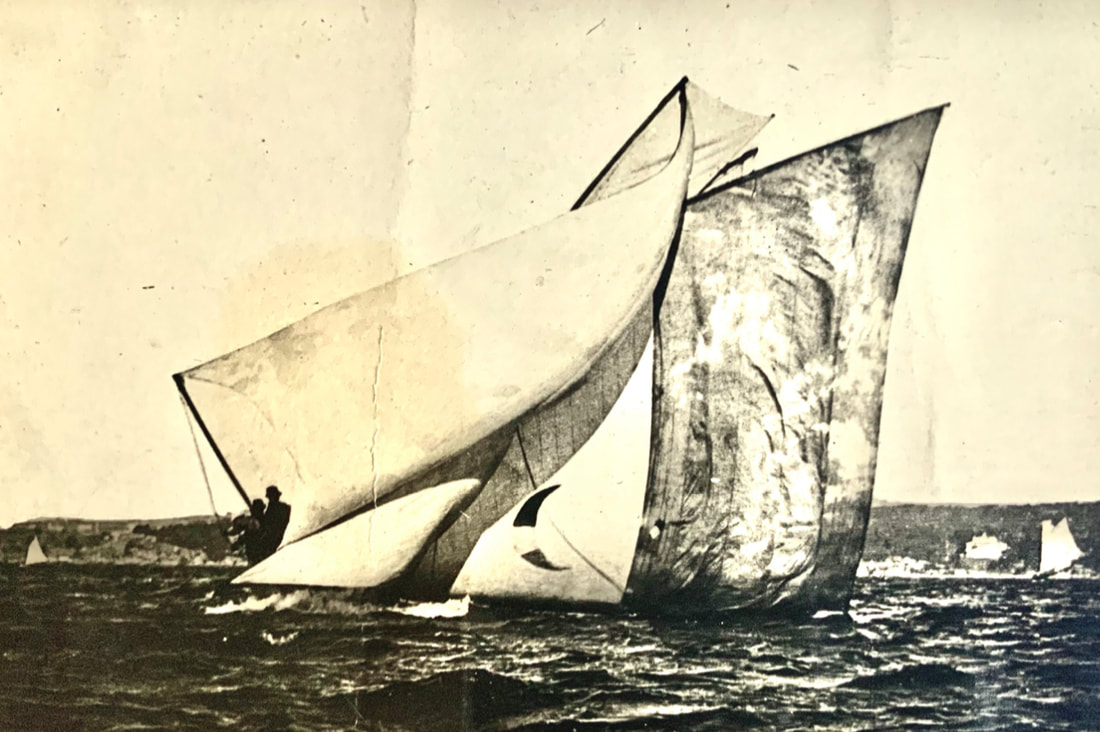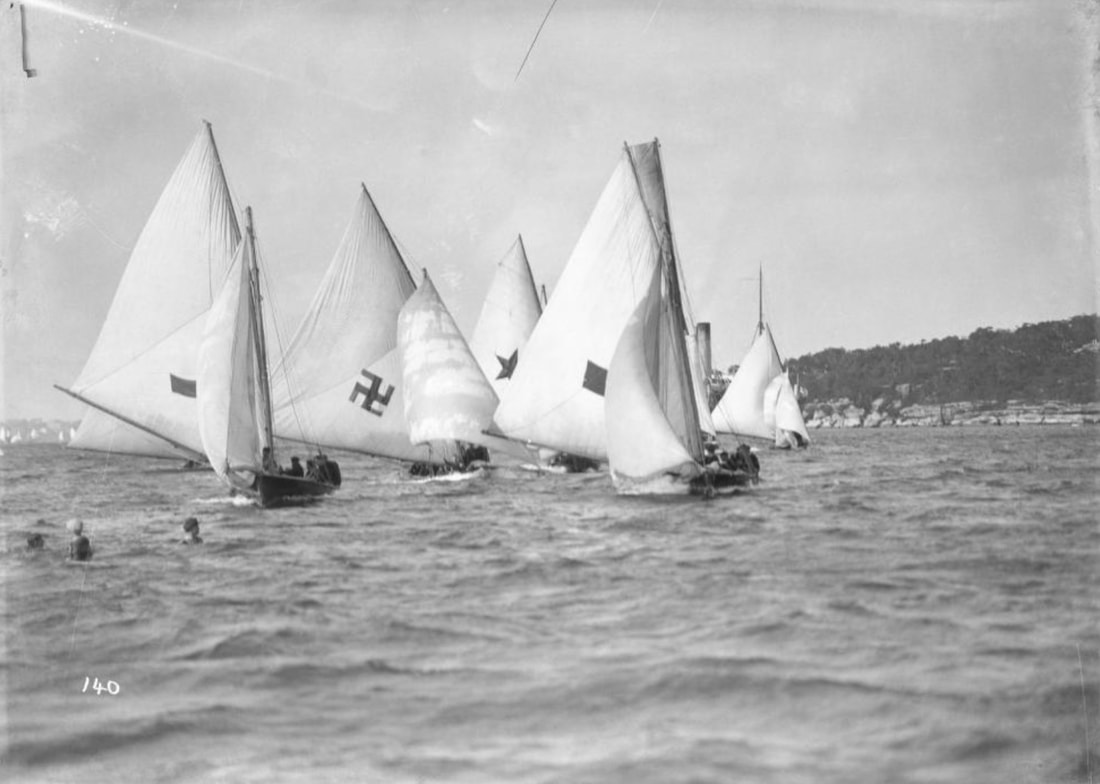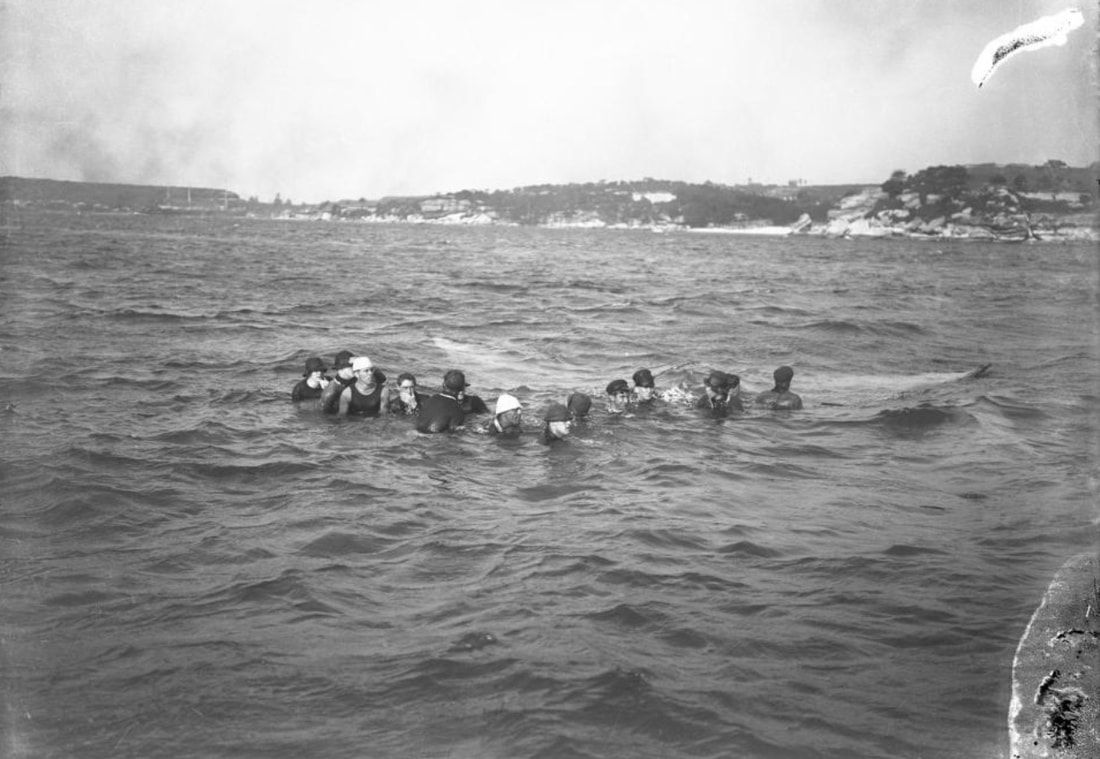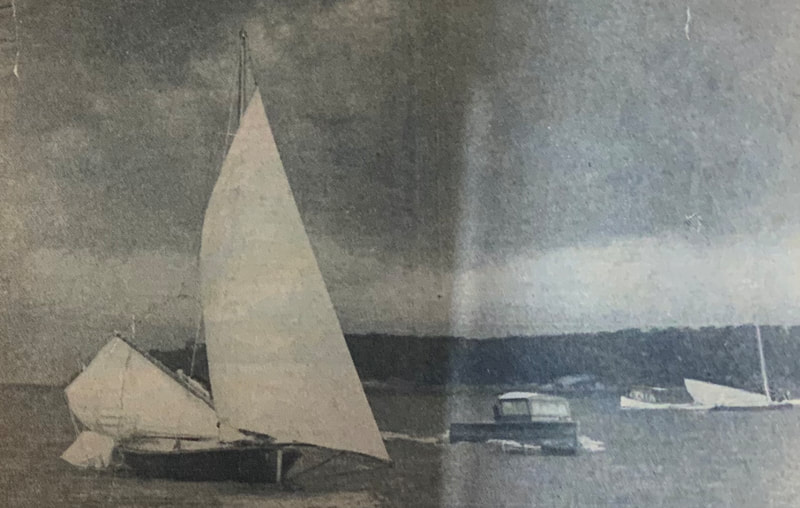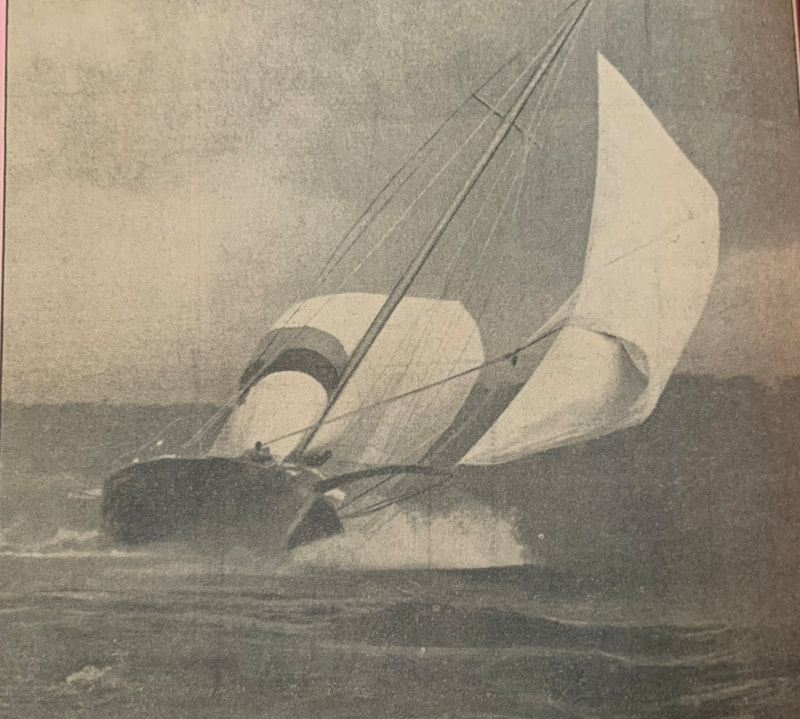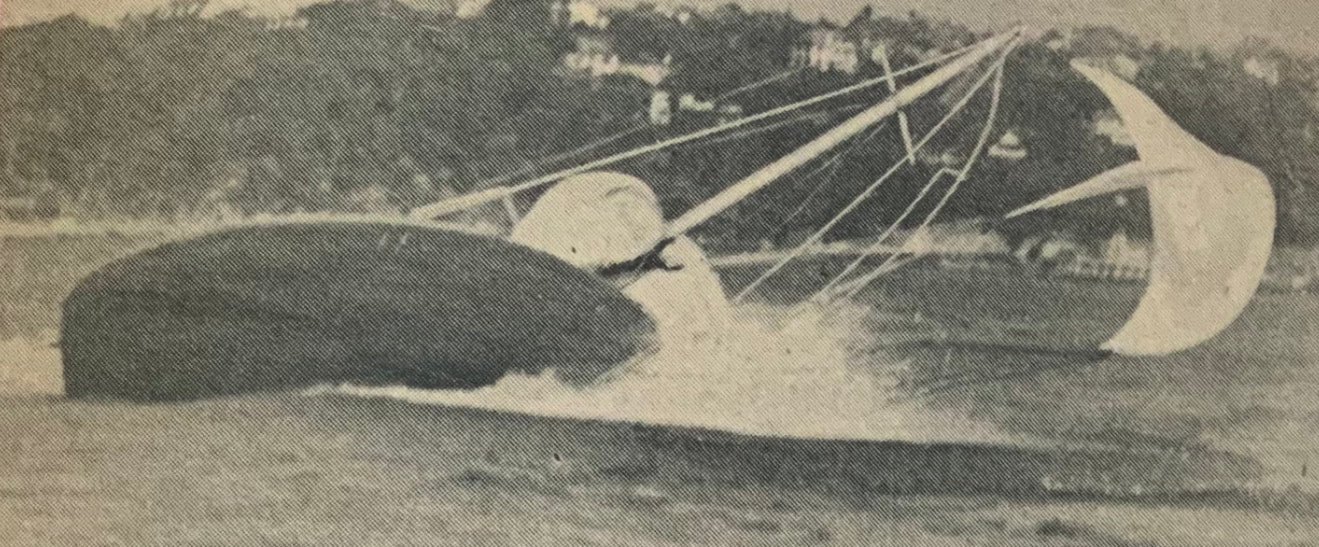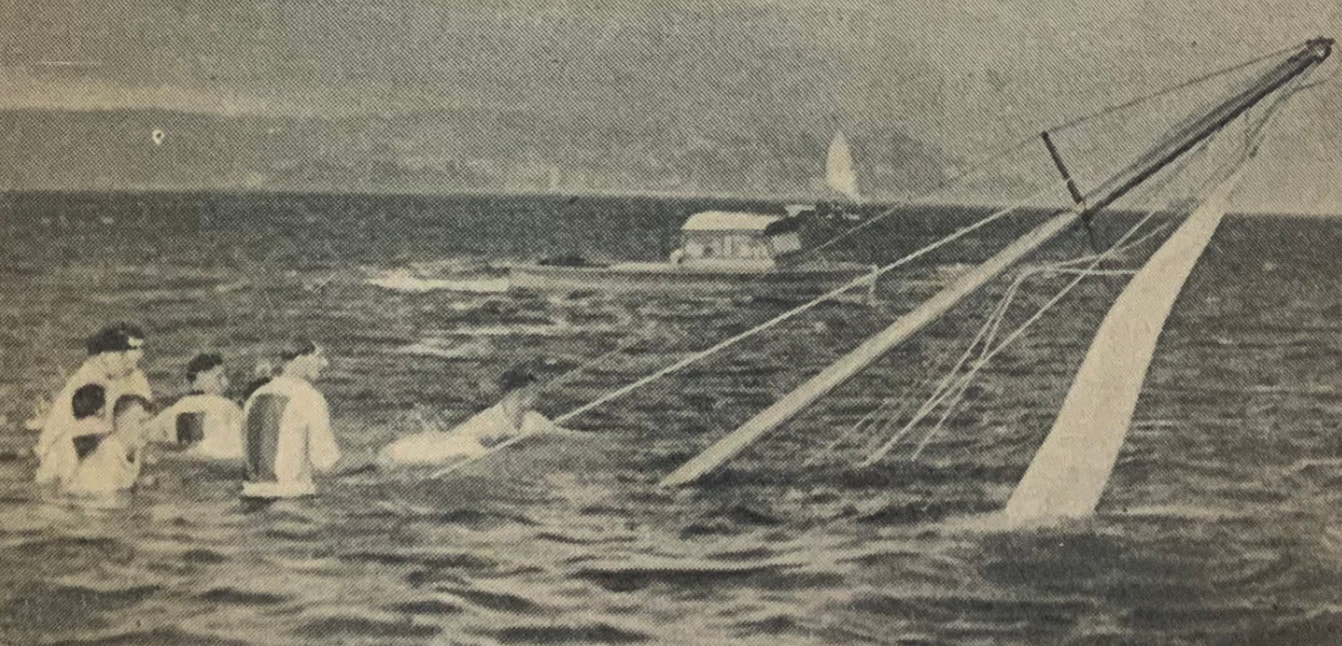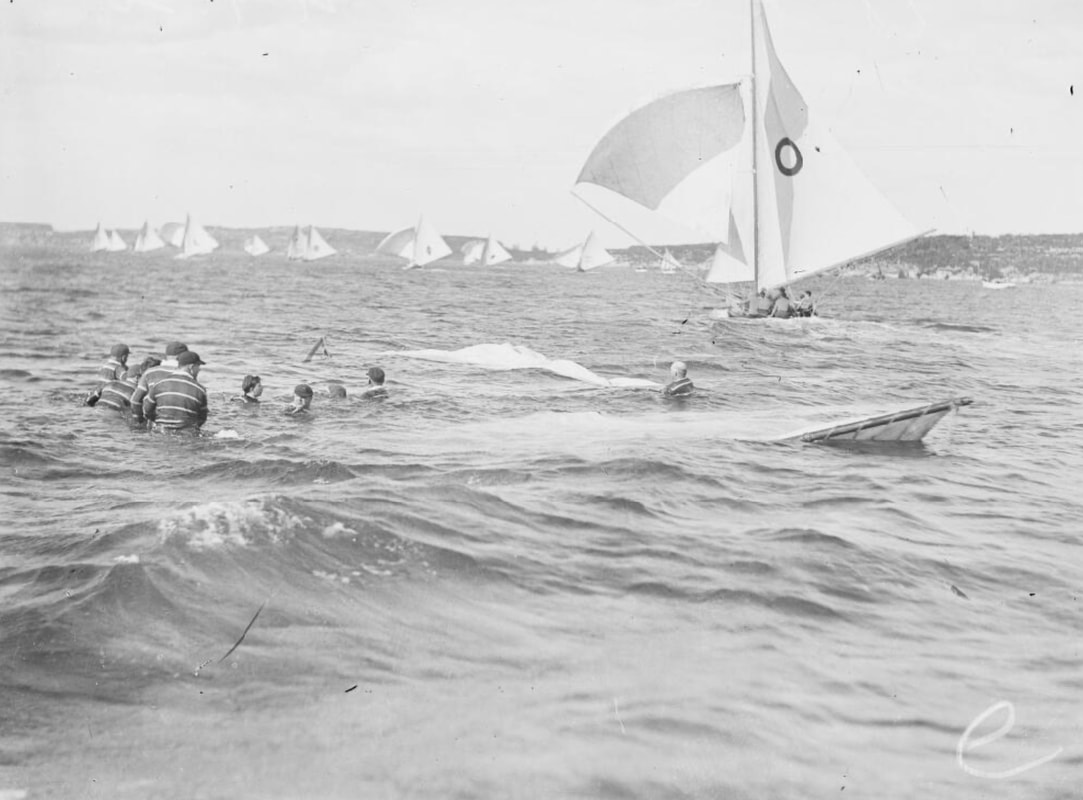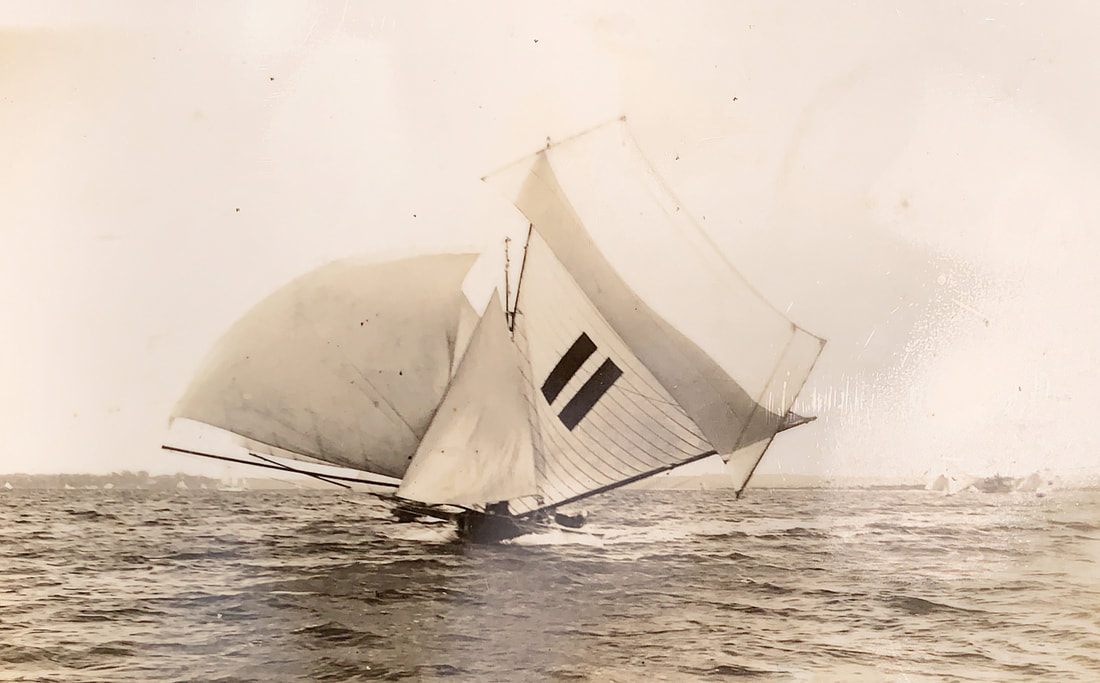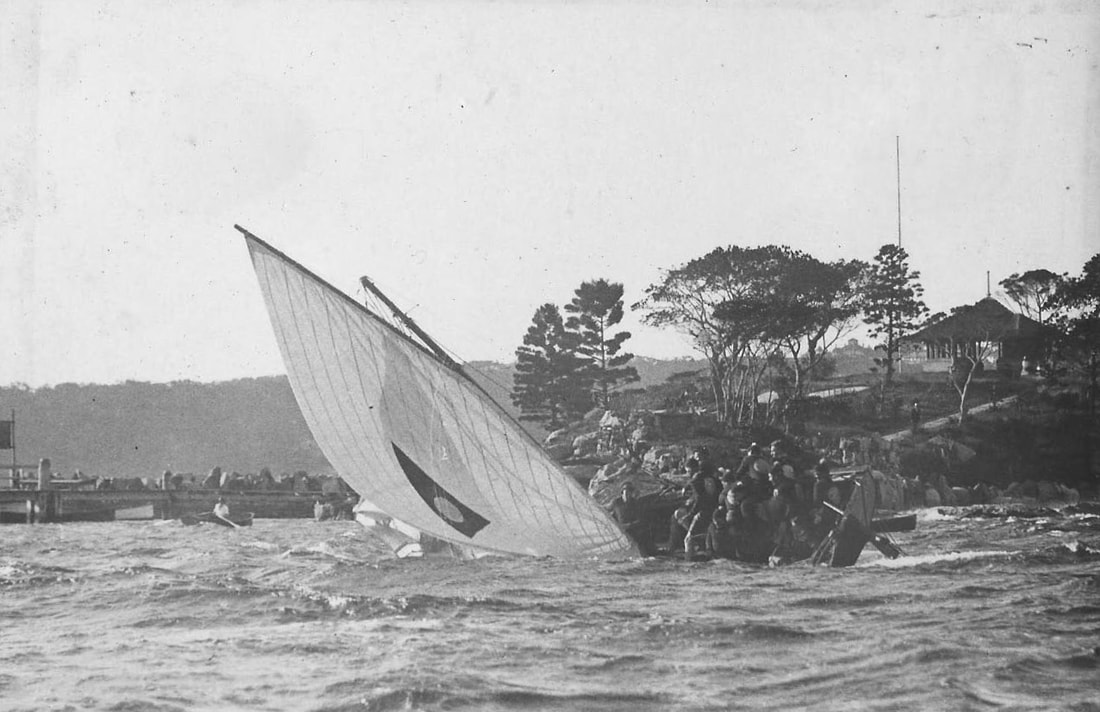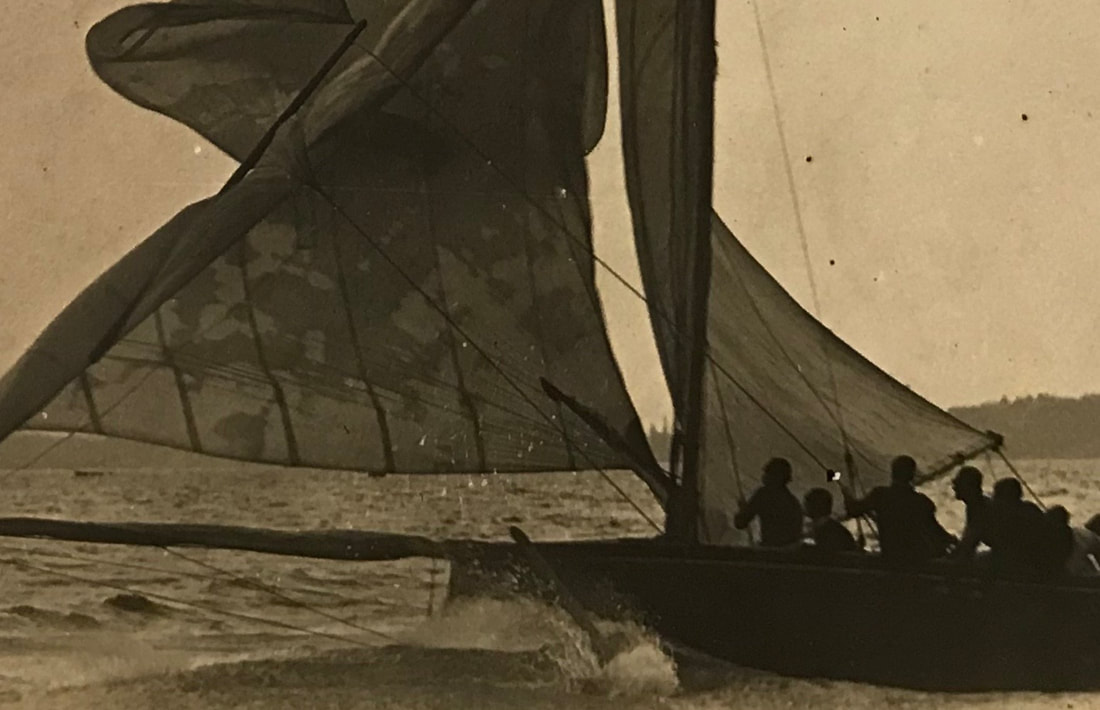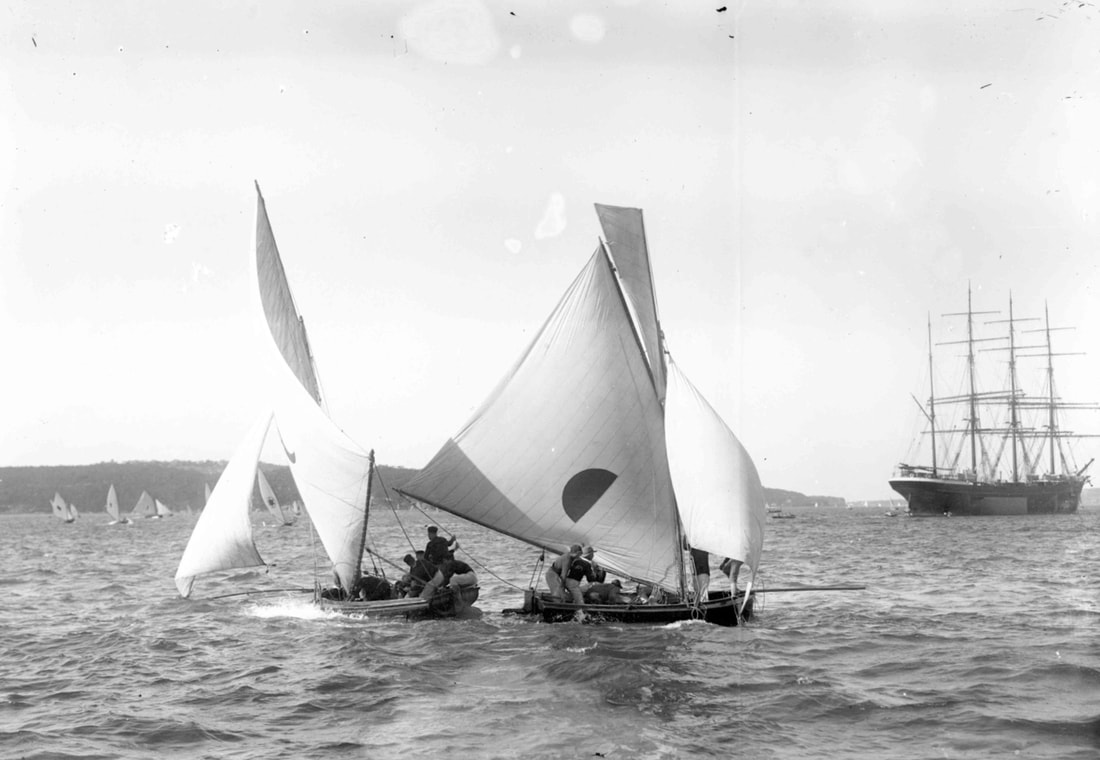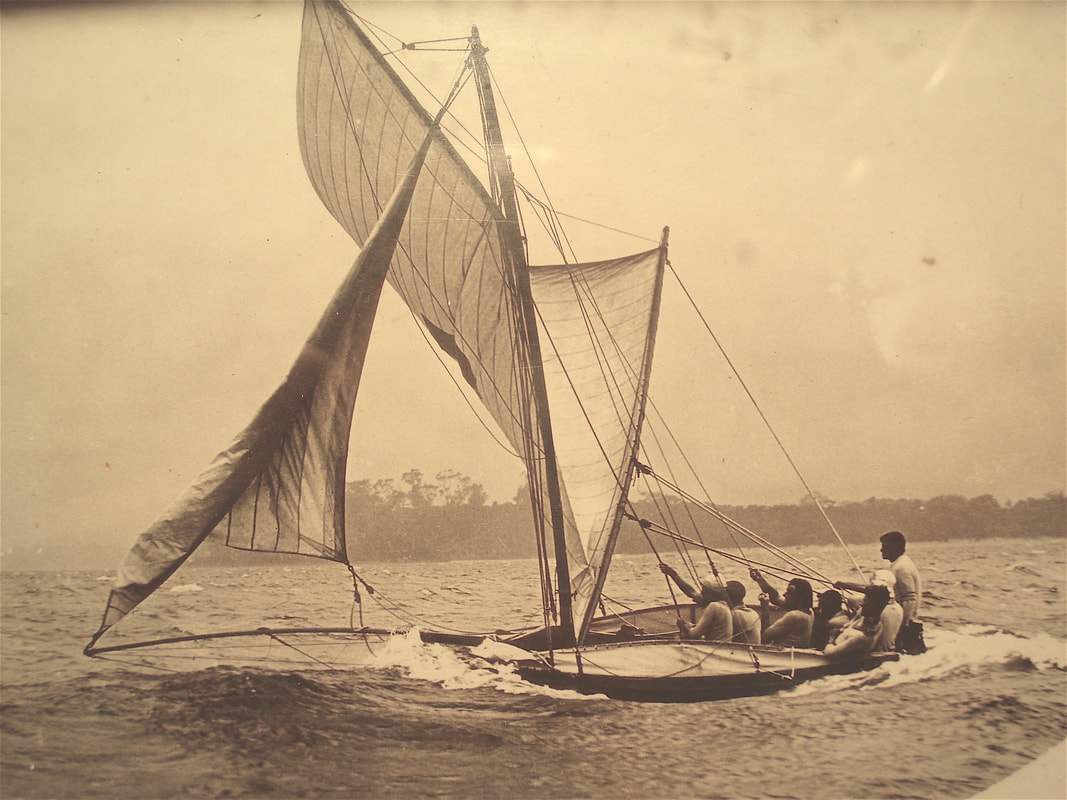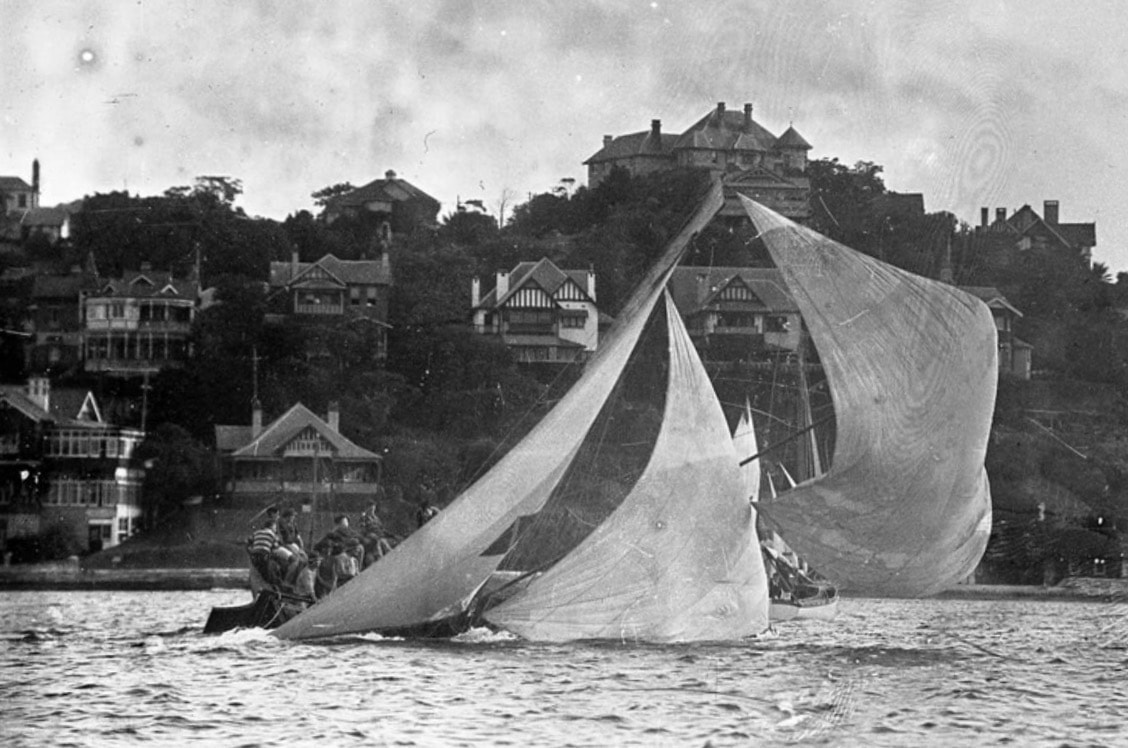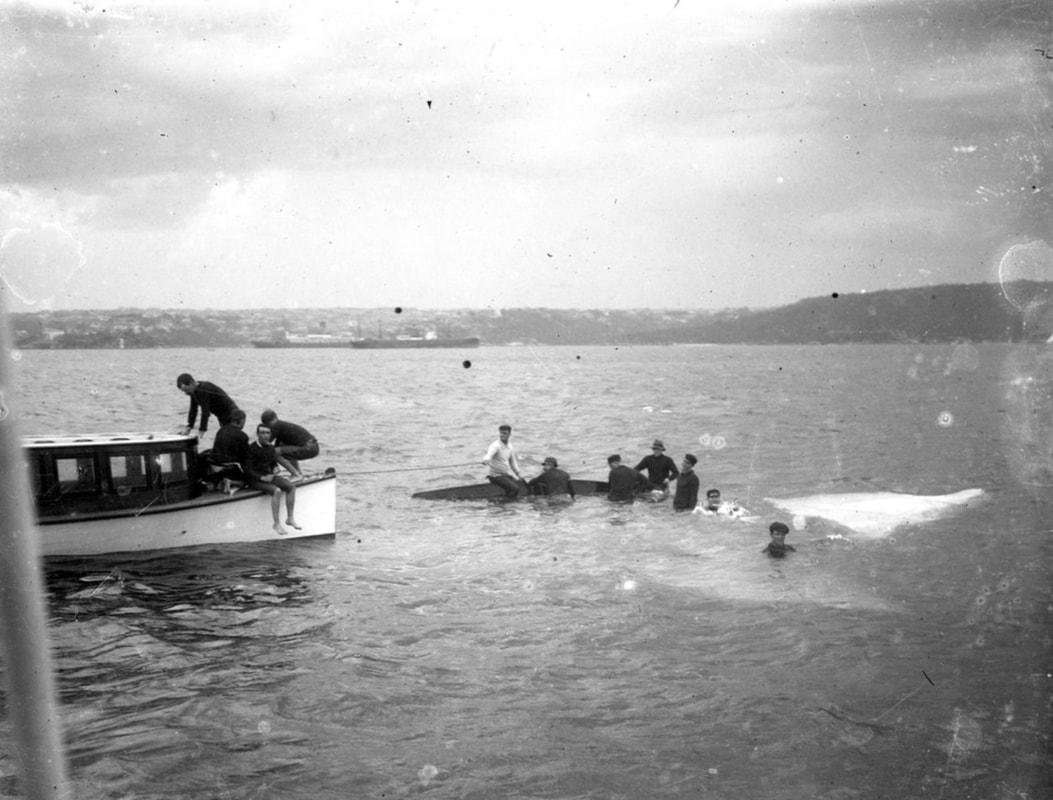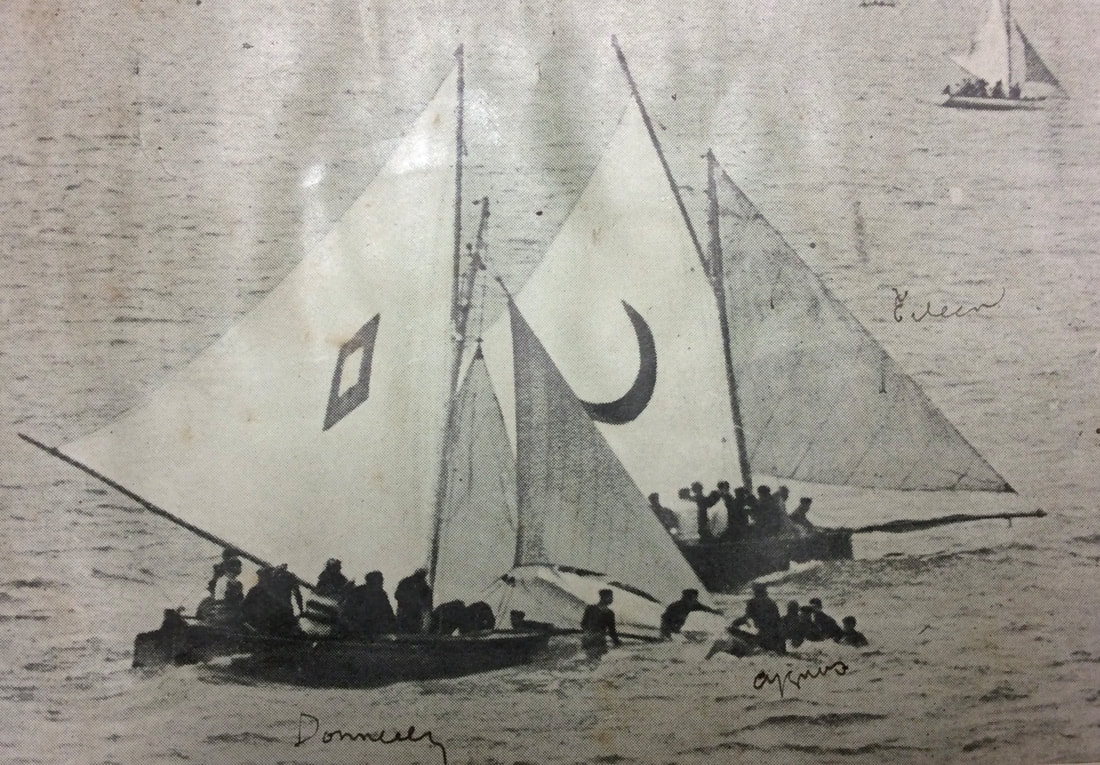A Page where we'll gather together shots of boats in difficulty, collisions, breakages and capsizes.
18-footer MASCOTTE with only a little OOPS!....the spinnaker bag has gone up with the sail! But the spinnaker is seriously sky-ing, quite dangerous with all that power on the end of a long lever arm. The forward hand is trying to haul down on the kicker, which was led in those days through the eye of the frd chainplate. Taken between 1918 and 1935, Hall Collection, ANMM. Part of Hall's launch is in the image.
Maybe they survived but this 18-footer is definitely on the edge. They have dumped both main and ballooner and there's not much more they can do. CUTTY SARK in the distance at right dates this to between 1925 and 1941, and the boat immediately beyond the one in trouble is probably GLORIA which would make it 1926-1941. John Stanley collection.
This 18-footer has lost one end of the spinnaker halyard from the top of the gaff...not a disaster yet, they may be able to reach it on the other tack. But if not, they won't be able to set a spinnaker with port pole on the run from the Sow and Pigs. The boat is unidentified, several boats carried various crescent insignia in this period, roughly 1910-1930, so depending on the colour this could be Defiance, Hero, Vision or even Quibree or Keriki. Hall Collection ANMM.
Billy Fisher’s Australia may be in trouble here on the run from the Sow and Pigs, with no extras set even though the boat beyond their bumpkin which is either Mascot or Avalon has spinnaker and ringtail set. Under their boom is Arawatta with Bermudan rig which dates this to 1930-31. There may even be a bit of bailing going on. Hall Collection ANMM.
This shot is from 1961, normally outside our cut-off point of 1950, but it's too good not to show. It's only on the OOPS! Page because they did capsize soon after!
Past President of the AHSSA John "JB" Bennett sent it in with the following story: “It is the 18th Nov. 1961 and I am one of the 6 hands in the ‘’JAN III’’ 18ftr. In an Easterly Gale . We were the only one to attempt the start off Clark Island. We were only afloat for about 20 mins. when the chartered Ferry Kanangra, loaded with spectators , came too close to windward of us , thus causing us to capsize. The Stannards launch Penrith , came to our rescue , and after a long tow in our semi-submerged state , we arrived at one of the sandy beaches east of Taronga Park Zoo. After standing the skiff upright , and the water bailed out , we were towed back to our club at Careening Cove at Kirribilli to be cheered by the ‘verandah admirals ‘ and later declared the ‘race winner’ The photo was taken by the SMH , and that is me ‘swinging out’ , 3rd from the stern.
Built ( I think- by Bill Barnett ) owned by Jack Boyd , named after his daughter Crew : 6 .. Skipper Jim Fraser , sheet hand , Harry Bird ...Swingers ... John Bennett & Tim Schofield & Kevin O’Keefee & Harry Cargill sitting in the bilge !! Only damage done on the day , was to our egos , and several battens in the mainsail !!"
Past President of the AHSSA John "JB" Bennett sent it in with the following story: “It is the 18th Nov. 1961 and I am one of the 6 hands in the ‘’JAN III’’ 18ftr. In an Easterly Gale . We were the only one to attempt the start off Clark Island. We were only afloat for about 20 mins. when the chartered Ferry Kanangra, loaded with spectators , came too close to windward of us , thus causing us to capsize. The Stannards launch Penrith , came to our rescue , and after a long tow in our semi-submerged state , we arrived at one of the sandy beaches east of Taronga Park Zoo. After standing the skiff upright , and the water bailed out , we were towed back to our club at Careening Cove at Kirribilli to be cheered by the ‘verandah admirals ‘ and later declared the ‘race winner’ The photo was taken by the SMH , and that is me ‘swinging out’ , 3rd from the stern.
Built ( I think- by Bill Barnett ) owned by Jack Boyd , named after his daughter Crew : 6 .. Skipper Jim Fraser , sheet hand , Harry Bird ...Swingers ... John Bennett & Tim Schofield & Kevin O’Keefee & Harry Cargill sitting in the bilge !! Only damage done on the day , was to our egos , and several battens in the mainsail !!"
Sydney 18-footer Alruth after a collision with the ferry Bellubera in 1961. Photo from the front page of the Daily Telegraph November 6 1961. A little later than our usual cut-off point of 1950, but this is the only photo we have of Frank Burrows (right) who features in The Tom Keddie Memorial Shield on the YARNS Page, and it's such a great shot it's worth repeating.
The remains of this spinnaker did not come from an 18-footer but there are plenty of stories of those that did end up on the Shark Island pile. It's a rare site these days as the rounding mark for all fleets has been replaced by a buoy 30 metres East (that's where the historical 18-footer replica Tangalooma is headed for in the background). But when it was the rounding mark it was a regular occurrence, including one or two of the replica fleet in the early 2000's before they moved the mark. This pile was usually a gybe mark and was often the scene of capsizes, some of which are depicted below. Photo by Tricia Smith a few seasons ago from the spectator ferry.
This shot appears also on the entry for Florrie II on the 18-FOOTERS Page, but its worth repeating. Florrie II collided with the yacht Wanderer at the Anniversary Day Regatta 26 January 1930. There seems to be some bailing going on. The boat was repaired and resumed racing on 8 February. A Hall photo from Jeff Toghill's book Sydney Harbour of Yesteryear.
Is Lilian in trouble here? Looks like they've just received a shy gust when their gear is set square, and with the boom in the water they'll be lucky to survive, but it's possible. This shot has to be from between 1908 when Lilian was built (by George Perry) and 1914 when she was sold to the Islands, a common fate for many 18-footers that didn't perform up to expectations. From a postcard in the Graeme Ferguson Collection, AHSSA.
A bad day for the crew in water is about to get worse with a whole bunch of the fleet closing up and getting ready to gybe at the Shark island mark. The presence of Swastika and Boronia (star) means that it was between 1913 and 1924. Others are hard to identify, but it could be Britannia front and centre right with what could be part of the Red Duster showing which would narrow it down to after 1919. Hall Collection ANMM.
Livonia* in the drink on 16 March 1912. They went in on the first work. That's Steel Point and Neilsen Park top right. Jack Robinson, Jack Junior and probably Wee Georgie Robinson aged 17 at the time are in the picture but I can't make them out. This was at the tail end of Livonia's second-last season, Jack sold the boat to Watty Ford in 1914 and it was sent to the Islands. The whole story is listed alphabetically on the 18-FOOTERS Page. Photo ANMM.
A bad day for inaugural World Champion 18-footer Taree in the second heat of the Australian Championship in January 1939. They've seen the squall coming and have lowered their main but the first gust is a beauty!
The jib and the windage of the mast is enough for the squall to throw the boat forward and over!
Nothing to do but wait for a tow. Photo sequence courtesy of Steve Kavanagh, from the Sydney Morning Herald January 27 1939.
10-footer Happy Days looks like going down for the count about 1938. Built in 1930 for Pat Books, Happy Days was occasionally steered by George Conway who may have built her, and may have had an interest in her as the sail insignia was the same as Conway displayed on Commonwealth* which was his champion Sydney 10-footer in the 1920's. Pat Books steered most of the time until the 1934-35 season when T McFarlane appears at the tiller a fair bit, though Books still occasionally appears until 1937. Charlie Miller became skipper in 1938 and the framed photo this image was taken from in John Stanley's collection notes that he was the skipper in the shot. The 10-footers faded when the Second World War broke out in 1939. The Sydney Harbour Bridge is only 6 years old in this shot. The photo was reprinted in a boating magazine in the 1950's with the claim that the boat stayed in this position while it sailed the last 150 yards over the finish line, but having sailed 10-footers for quite a few years in the 1990's and early 2000's I suspect that this is highly unlikely to be true.
It's an awful feeling, your race is over, there's a lot of hard work ahead and the rest of the fleet sails happily away from you. I can't identify the boat, but the one sailing away is Arawatta*, and with the rare Bermudan rig and the circle insignia I can date this almost definitely to between January and April 1930. If I find a photo with the crew wearing those jerseys I might be able to identify them. They could be one of the low-handicap boats if they just capsized as Arawatta was always on a low handicap, but they might have been close up with the rest of the fleet when they pickled. It looks like a Sou'Westerly, a relatively rare breeze in the Sydney Summer, and always gusty and shifty. They are not the first crew to lose it in a Sou-Wester, and they won't be the last.
Alright, I know it's not a collision, breakage or capsize, and it's barely a difficulty, but someone definitely said "Oops!" when they noticed they had put up the ringtail back to front! But they still won the race, so no problem. This is the Sydney 18-footer HC Press (II) winning the Australian Championship in Perth in March 1925 with Chris Webb at the helm. I'm sure "Oops" wasn't the only word said. I've searched the contemporary newspaper reports and can find no mention of the ringtail problem, but otherwise the details match the Championship race. From a postcard collected by the late Graeme Ferguson.
Furious takes a dive off Shark Island in 1929. Built by Tom Phillips of Balmain for Bob Gourlay in 1924 she was snub-bowed and had no heel (I mean the heel or skeg under the tuck, she sure has plenty of heel in this shot!) Photo Sydney Flying Squadron collection. It made the cover of the weekly programme of 9 November.
I put up this photo from John Stanley's collection as an unidentified boat and wondered if they survived. John tells me that the boat is Jack North's Nerang (built 1944) and they did survive, as there is another photo and a complete story written by owner-skipper Jack North about the race. When I get around to chasing that up I will post both photos and the whole story.
This shot from the Harry Thompson Collection shows an unidentified boat with a flogging spinnaker, but if you look closely you can see that one of the spinnaker pole sections has broken. The outermost section is still attached to the spinnaker tack and is flogging dangerously on the jib luff. The innermost section is still attached to the snotter on the mast but you can see its splintered end just in front of the jib clew. The rest of the broken section is just spacing into the water behind the bow. Great timing for the photographer, it must have happened just a split-second before he pressed the shutter! I know how they feel, we did it on the replica Britannia a few seasons ago. The photo below is a close-up. Recently this photo turned up in another collection, identified as Pastime, but if you go to the YARNS Page and read the Yarn on THE 1913 INTERSTATES AND THE WESTANA GALE you'll see why this is probably a false identification.
It's the 1890's and two old-style 14-footers have just collided. The boat on the left is Peter Cowie's Cutty Sark, and the crew appear annoyed enough by the collision to hang on to the other boat's mainsheet.....if they hung on the other boat could easily capsize. The other boat is unidentified. It looks like they have sheered the end off their bumpkin as neither the forestay, jib or any stays are still attached. They would be in danger of losing their mast. Photo Hall Collection, ANMM.
I previously had this image in the FLEETS section, but this is a better home for it. It is a photo of an unidentified West Australian 18-footer which illustrates some of the difficulties of sailing these boats downwind in a strong breeze. Taken on the Swan River off Resolution Point in the early 1900's, the photo was supplied by WA Olympic veteran Andy White from a copy he has of the original in the Swan Yacht Club. They appear to be going dead downwind or a little by-the-lee, and not able to hoist a spinnaker (perhaps it is after a race). The third guy from the front appears to be holding the topping lift which is hauled on a bit to raise the boom, a technique often used in 18's to depower the sail in light stuff, but I've never tried it or seen it done in a strong breeze. It would make the boat even more unstable when running square. The forward-most bloke seems to be holding a halyard, probably the peak halyard controlling the angle of the gaff, and the second bloke is holding both ends of the peak head spinnaker halyards, probably in a vain attempt to stop the gaff from going too far forward which is also inherently unstable. They have put both lee-cloths up, which I have not seen before. If they survived this run they were very lucky.
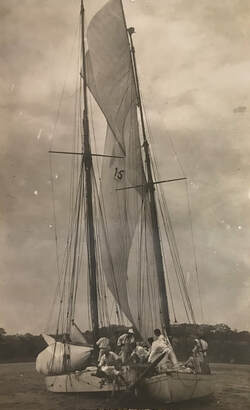
Allright, I know they're not open boats, but I just wanted to show the kind of thing that sometimes happened on Sydney Harbour. Two unidentified but quite large yachts around the turn of the 20th Century have have a collision. Hall Collection, ANMM.
King brothers' 18-footer Avalon looks like they're going down for the count off Darling Point in the 1920's. Photo Hall Collection, ANMM.
Once down, that's it for the day. There was usually a launch around that could tow you to the nearest beach where you righted the boat, bailed it out, and sailed or got towed home.
Looks like a 22-footers' race in the 1890's up the Parramatta River so could be either a Johnstones Bay Sailing Club race or the Balmain Regatta.
Sometimes capsizes can be significant. On 29 January 1910 the Perth Flying Squadron Challenge Cup, the de-facto Australian Championship was raced for in a single race in Sydney. Legendary WA skipper Chris Garland was fancied with Cygnus, but capsized just after the start! Sydney boats Eileen and especially Donnelly appear to be caught up in it. Golding family , Billy Golding's scrapbook, ANMM. Billy Golding built Eileen, which later became Arline (II).
